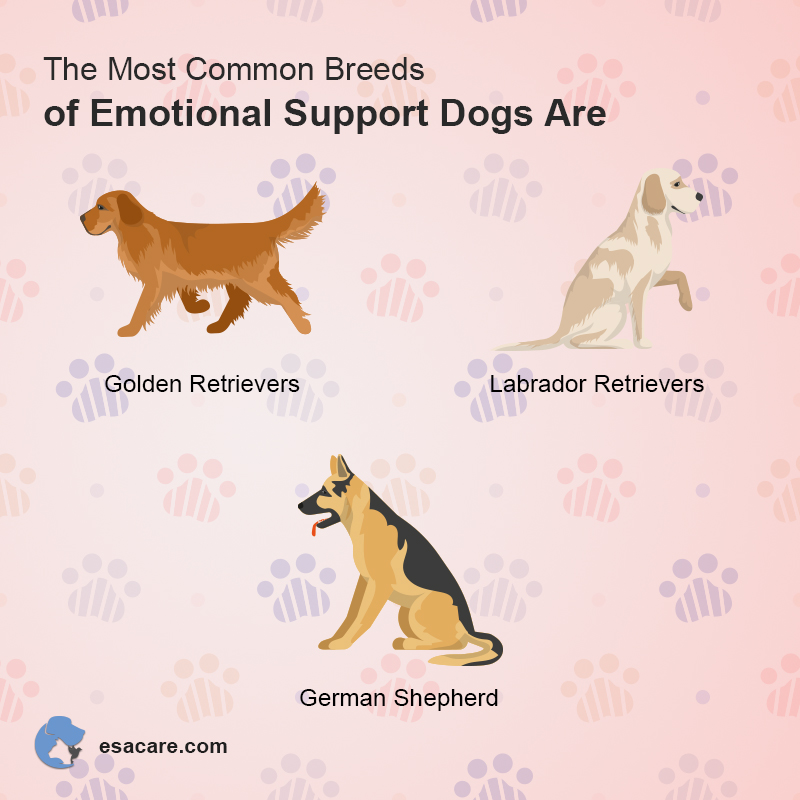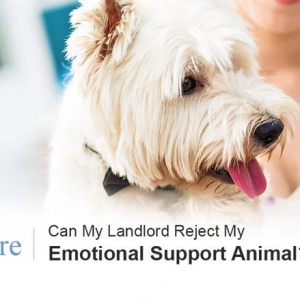15 Emotional Support Dogs That Can Help With Anxiety
When dealing with anxiety, an Emotional Support Animal will go a long way in supporting your therapy. While there are several animal options, dogs are the best ones because their goofiness makes them a bit more entertaining and adventurous than other animals. Though there are several dog breeds to choose from, we have reviewed fifteen of the best options for you in the tidbits below.
Your ESA Dog can be your best companion – Click the button below!
Table of Contents
hidden-toc
Big Dog Breeds for Emotional Support Animals
1. Labrador Retrievers
Labrador retrievers live for 10-12 years and can grow to adult heights of 21.5-24 inches. The dogs are often yellow, gold, or cream. Though Labrador retrievers have high drool levels, they are generally quiet and will not bark unnecessarily. The dogs were originally found in Newfoundland, Canada, in the 1500s, from whence they migrated to Britain in the 1800s.
Personality traits
Since their introduction to the U.S population in the 1900s, Labrador retrievers have slowly become among the most popular dog breeds. This might be because of their social and friendly nature. Their calm demeanor makes it easy for pet owners to get along with this dog breed. The playful nature of Labrador retrievers makes them the best companions for people with mental health conditions. Furthermore, the dogs are quite intelligent, a trait that helps them understand the emotional whirlpool that their owners will often go through when experiencing panic attacks.
Behavior
Labrador retrievers puppies have stable natures and love working. They need at least 20-30 minutes of vigorous workouts daily to satisfy their love for the activity. Even with these behaviors, Labrador retrievers are caring and loving animals that love staying around their owners. For this reason, the dogs will often get quite anxious when their owners are away for lengthy periods. Furthermore, these retrievers are easy to train, obedient, and loyal. These qualities make them easy to handle and thus perfect choices for those owning a pet for the first time.

Unhealthy Labrador Retriever
Diet (Best dog food for Labrador retrievers)
As big dogs, Labrador retrievers need a lot of nutrition. Moreover, with their love for eating, you should be prepared to meet your dog’s dietary needs. Their ideal diet comprises 60% vegetables and 40% meat. Mineral-rich foods and vitamins are also essential in Labrador retrievers’ diets because they are prone to bone deformities. Remember to give them a diet primarily comprising wet rather than dry foods.
Health problems
Labrador retrievers are generally healthy dogs. However, they are prone to a range of health issues when you do not properly care for them.
In a few instances, Labrador retrievers contract cancer. As such, it is essential to take care of your dog’s health if you choose this retriever as your emotional support animal.
2. The Great Pyrenees
The Great Pyrenees live for 10-12 years and grow to adult heights of 25-32 inches. Most of them are reddish-brown, badger, or gray. They have low drool levels but a high tendency of barking, a trait that makes them unpopular for those who do not want noise. The Great Pyrenees originally came from France.
Personality
The Pyrenees are renowned for their meek and gentle natures. They are also very devoted to their owners and will always be at hand to help them out. Their readiness and willingness to help their owners make them among the best emotional support animals. Since the Pyrenees are quite intelligent, they love trying to figure things out. To keep them busy, you can give them puzzles to solve, and they will easily get through them. Furthermore, the dogs are very friendly towards kids. Therefore, if you have children in the house, you can rest assured that your Great Pyrenees will not harm them. They are also perfect dogs for those who travel because you can leave them alone for long periods without having to worry about them.
Behavior
The Great Pyrenees are in their natures, guardians. As such, they will start barking when they encounter something that they deem threatening. You can make your dog sociable by taking it to the park and other public places. Taking the Pyrenees out will also tame their barking. Remember to keep the leash on them when out in public because of their high wanderlust levels.
Click the button below to keep your ESA Pet close to you.
Diet
To keep Great Pyrenees healthy, it is essential to understand its ideal dietary balance. The dogs need the correct balance of carbohydrates, vitamins, and proteins to remain healthy. As big dog breeds, Pyrenees will need lean meat in their diets to build up the foundation of their muscles. To avoid obesity, you should include chicken fats, salmon oil, and plant oils in their diets. The reason for this is that the bodies of the Pyrenees can easily break down these lipids. This reduces the risk of obesity in your dog.
Health Issues
Though not all dogs will suffer health issues, you should have all the essential information regarding your Great Pyrenees to prevent any conditions. The thick fur of this dog breed makes it sensitive to heat. To this end, you should be at hand to care for your furry friend when it feels too hot. Some of the health conditions you should be wary of include:
- Bleeding disorders
- Neurological issues
- Joint conditions
- Dental diseases
- Eye diseases
- Obesity
- Parasitic infections
- Bone issues
- Heart conditions
Thankfully, the above conditions can be kept at bay by sticking to regular health check-ups and a good diet.
Book an Appointment by clicking the banner below.
3. Saint Bernard
A Saint Bernard will live for 8-10 years. It can reach an adult height of 2 feet, 2 inches, and sometimes it grows to heights of 2 feet, 6 inches. The dog has a base white color with different pattern combinations. The breed’s most common colors are combinations of white and red or white and bridle. Saint Bernards drool a lot but have low barking tendencies. They are originally from Italy and Switzerland.
Personality
You might remember a Tom & Jerry episode where Tom was helped by a dog when he had almost frozen to death. The dog, in this case, was a rescue dog, most probably a Saint Bernard. The dogs are very calm and get along quite well with kids. They are also caring and loving animals that love pleasing their owners. The dog will try to live up to your expectations when you explain what you want and expect. Its obedient nature means that you can comfortably leave a Saint Bernard alone with your children.
Behavior
Most people are worried about the behavior of a Saint Bernard because of the animal’s huge size. Though this is a big dog, it is equally kind and loving. It often is not aggressive, but if you expose it to a threat, the dog will become aggressive. Saint Bernards can be great companions if you give them some training to improve their socialization skills. Keep in mind that the dogs are very affectionate and will love spending as much time as possible with you. This explains why their owners’ absence affects the dogs so much.

Owners of Emotional Support Dogs
Diet
You should give a Saint Bernard the right diet to keep it healthy. When feeding the dog, take its weight, age, metabolism, build, and activity level into account. The right food is an essential element for your Saint Bernard. Its feed should primarily contain protein-rich foods to prevent obesity.
Health issues
As big dog breeds, Saint Bernards need more care than average-sized dogs. There are several health issues you should keep an eye on when keeping the dog. These include:
- Elbow and hip dysplasia
- Polyneuropathy
- Epilepsy
- Eye conditions
- Dilated cardiomyopathy
- Osteosarcoma
It is crucial to point out that your Saint Bernard does not have to suffer the above conditions. However, you should feed your ESA right and take care of it to protect your dog from these conditions. Moreover, ensure the dog gets enough exercise but not too much of it during hot weather. This is because you want to avoid the excess heat that the exercise will generate, seeing as the dog’s thick fur makes it sensitive to heat.
Click the button below to keep your ESA pet legally!
4. Standard Poodle
A standard poodle lives for 12-15 years and can grow to over 10-12 inches tall at its shoulder. The dog can be apricot, brown, red, silver, cream, black, gray, white, or silver in color. Standard poodles do not bark so much, and they have low drooling tendencies. The origin of this dog breed is, in itself, a history of its own. Standard poodles are originally thought to be from Germany though some people believe that the French developed this dog breed. In some quarters, it is believed that standard poodles are the results of the crossbreeding of several water dog breeds in Europe.
Personality
Standard poodles are loyal and quite loving. They are very protective of their owners. Though the dogs are considered elegant sometimes, they are quite goofy when expressing themselves due to their exquisite look. When a standard poodle is fond of you, it tends to play around you. Nowadays, these dogs are considered the epitomes of luxury and prestige, though, in the past, they were water dogs that helped fishers. This explains why they are obedient and highly trainable.
Behavior
Standard poodles make up a peculiar breed of dogs whose behavior is almost unpredictable. Their behavior will differ based on the situation in which they find themselves. Below are some guidelines on the behavior to expect from your standard poodle in different situations:
- When your standard poodle is below a year old, it can be quite hyperactive. At this stage, your pup will want to play almost all the time. It sniffs, bites, and runs around your house.
- Some standard poodles are shy and will be quite clingy to their owners. In this case, the pup often stays close to you and follows you around. To this end, leaving your pup for a long time will distress it.
- Standard poodles have the habit of jumping on people. This, for them, is a form of enthusiastic greeting.
- At times, standard poodles are aggressive.

Pets Provide Emotional Well-Being
Diet
The best way to ensure that your standard poodle remains strong and healthy is to take special care of it. Feed the dog twice daily and factor in its physical activity. The poodle’s feed can comprise beef, beans, carrots, or chicken.
5. Golden Retriever
A golden retriever’s lifespan is 10-12 years. It grows to an adult height of 21-24 inches and mostly comes in yellow, cream, or golden. A golden retriever has a low barking level and will often only bark to alert its owner. The dog drools a lot. Golden retrievers originally came from Scotland, the United Kingdom, and England.
Personality
Golden retrievers are sweet and calm. They are among the most friendly dog breeds, which explains why they are now quite common in the U.S. As one of the most intelligent dog breeds, golden retrievers make perfect ESAs for kids, adults, and the elderly. Moreover, these dogs easily adapt to new surroundings. This makes them ideal choices for people who move around a lot. Golden retrievers are so loving and will always be there to lend a helping hand. Furthermore, they love playing with kids.
Behavior
Golden retrievers are nonaggressive, obedient, and friendly. This explains why these dogs have low barking tendencies. Owing to their kind nature, these dogs make great assistance animals. However, they should not be left alone for a long time because they do not like this. As energetic dogs, golden retrievers will love playing throughout the day. They are also very obedient and will love pleasing their owners.
Diet
Golden retrievers need a high-quality diet because of their high activity levels and strong builds. Furthermore, there is a risk of the dog developing skin issues if you do not give it the right diet. Below are some tips on how you can correctly handle your furry friend’s diet:
- Include some protein in its diet.
- Steer clear of foods that have preservatives.
- Balance the diet by including grains in it.
- Do not solely rely on dry foods to keep your dog in optimal shape. Include fiber-rich foods as well.
- Give your dog natural treats like homemade biscuits to maintain their sugar levels within acceptable limits.
Looking for an ESA Letter for your dog? Click the button below!
Health issues
Owing to their strong builds, golden retrievers generally live healthy lives. However, they can have cancer, hip dysplasia, elbow dysplasia, epilepsy, and separation anxiety. Though these conditions are common, you can take several measures, including getting an early diagnosis when you notice anything new in your animal and investing in precautionary measures to protect your ESA from them.
6. Boxers
Boxers will live for 10-12 years with optimal care. They generally grow to approximately 21-26 inches at their shoulders. In most cases, the dogs will come in fawn, white, or brindle and black masks. The barking levels of boxers are moderate, and their drooling levels are high. These dogs originally come from Germany.
Personality
As the name boxer will suggest, this dog breed will give its owners some sense of protection. Some history of World War I shows that the dogs were used as an attack, guard, and messenger dogs. This might be because of an ancestral trait. To this end, boxers are always alert. They are often described as watchdogs owing to the watchful nature that makes them seem like they are always on their guard. Some people say that boxers are aggressive. Even so, they will only be aggressive when they are protecting their owners against a threat. Though boxers give a somewhat serious dog vibe around kids, they are still playful and patient. They also have unique personalities that make them stand out from other ESAs.
Behavior
Unlike most animals, boxers have diverse traits that you should be conversant with before knowing if these are the best options for you. Here are a few facts to help you understand a boxer’s behavior:
At times, the dogs get excited and will jump around. When you notice a boxer getting jumpy around you, this is their means of expressing their affection. The behavior is typically seen in puppies.
- Boxers are, at times, stubborn. Thankfully you can control stubbornness in your dog with a few discipline sessions.
- The dogs love their owners and will want to spend as much time as they can with them. They are thus not the best options for people who will be away most of the time. This is because boxers do not like spending a lot of time alone.
- Boxers are friendly animals and will get along with other dogs well. In fact, they will also live peacefully with cats.

Pets Around the World
Diet
Like humans, a boxer needs the right diet to remain healthy. Most people choose to give their dogs a lot of dry foods. Even so, dry foods, when given in excess, are not healthy for your dog. Here are some considerations when giving your boxer food:
- Stick to whole foods and a natural diet.
- Ensure the diet comprises 18-20% proteins.
- The number of healthy fats, these are unsaturated ones, should be less than 5%.
- Stick to a well-balanced diet.
Health issues
As strong and healthy dogs, boxers need the right diets to maintain their bodies. At times, the dogs can contract different diseases because of their inherited genes, even when you have given them the best diet. This is why it is best to ask a breeder about your dog’s parents’ health clearance before going home with it. The potential health issues you might deal with in a boxer include:
- Hypothyroidism
- Tumors
- Arthritis
- Hip dysplasia
- Cardiomyopathy
Book an Appointment by clicking the banner below.
7. German Shepherd
A German shepherd can live for 10-14 years. This big breed dog can grow to a maximum height of 1 foot, 10 inches- 2 feet, 2 inches. The dogs are mostly black, grey, silver mixed with black or black mixed with tan. German shepherds have high barking levels and low drooling tendencies. As the name suggests, these dogs are from Germany. Originally, they were bred to become work dogs. In this role, they helped farmers protect their sheep. After World War I, the dogs gained immense popularity as companions.
Personality
Initially, German shepherds will be mostly reserved. Even so, once they become friends with you, they are very loving. Most people are scared of these dogs because of their large sizes. Even so, they are very approachable animals. Owing to their backgrounds as working dogs, German shepherds are very obedient. This trait also makes them one of the easiest dog breeds to train.
Behavior
In general, German shepherds are silent, but they can become quite aggressive. The aggression generally follows their exposure to a threat. It is best to train your dog to socialize from a young age. If you wait too long, the dog might become extremely quiet and shy. If you get a German shepherd, be ready to exercise because this dog breed is very active and will want to go out regularly for play.
Diet
German shepherds, like other breeds, need a balanced diet for them to thrive. Even so, their food should have high protein amounts to match their high activity levels.
Health problems
Like other dog breeds, German shepherds suffer from different health issues during their lifecycle. The following are the most common ones:
- Hip and elbow dysplasia leading to arthritis
- Gastric dilatation-volvulus (GDV)
- Spinal Cord Degeneration in older dogs
- Allergies
- Exocrine pancreatic insufficiency leading to the inability to digest food properly.
Thankfully, you can lower the risk of your dog contracting the above conditions by sticking to a proper diet for it.

Common Dog Breeds
8. Samoyed
Samoyeds typically live for 12-14 years. As big breed dogs, they will grow to attain adult heights of 1 foot, 7inches- 2 feet. Most of the dogs are yellow, white, cream, or biscuit. They have low drooling potentials and moderate barking levels. Samoyeds are originally from Siberia.
Personality
Samoyeds are renowned as gentle and affectionate animals. The dogs are quite friendly and will spend most of their time around the people they love. They also love helping with housework. Moreover, they are quite friendly to children despite their large, and often intimidating, sizes.
Behavior
If you are looking for a loyal ESA, the Samoyed should be one of your first choices. This dog will always be by your side, something that will make it an exceptional watchdog. Though this is mostly an advantage, it also means that you cannot leave the animal alone for a long time. This makes it a burden for people who are away for long periods. The Samoyed is a mostly friendly dog breed, but, at times, its hunter-like nature will take over and cause your dog to start chasing the small animals around your home.
Diet
Your Samoyed’s diet should primarily comprise raw food, including bones, meat, vegetables, eggs, and fruits. You can also give your dog dry foods. However, these have fewer health benefits than the natural foods that should ideally make up many of their diets.
Stay Healthy with your ESA Pet! Get your ESA letter by clicking the banner below.
Health issues
Samoyeds are among the most powerful dog breeds. Nonetheless, they are prone to a few conditions. Here are some of these diseases:
- Glaucoma
- Diabetes mellitus
- Cancer
- Progressive retinal atrophy
- Patellar luxation
- Subvalvular aortic stenosis
- Samoyed hereditary glomerulopathy
9. Siberian Husky
Siberian huskies live for 12-15 years. They attain heights of 20-23 inches at their shoulders when they reach adulthood. Most Siberian huskies have a white and dark combination owing to their pure white fur mixed with black. Their barking tendency is high, whereas their drool levels are moderate. As their name suggests, these dogs come from Siberia, specifically the eastern region in the Chukchi Peninsula. From here, huskies were introduced to Alaska.
Personality
Siberian huskies are friendly. Though they are not essentially watchdogs, they will also alert you if someone is lurking around. A few people erroneously assume that huskies are violent, probably because of their large sizes. Even so, the dogs are quite friendly to kids, other dogs, and even strangers. However, you should be vigilant if you want to keep a cat in the same environment as a husky. Huskies love running around. Though they do not need a lot of space to support this habit, it is best to provide an open area for them to run in.
Behavior
Huskies possess an innate to dig around, so if you find yours digging through stuff, do not consider it a destructive animal. This is just the animal following its instinct. The loving and expressive natures of Siberian huskies make them perfect companions. Owing to their intelligence, the dogs are straightforward to train.

Worlds Owned Pet
Diet
If you are holding out on getting a Siberian husky because you believe it will eat a lot, you can relax. This dog breed has a moderate appetite. Even so, when feeding it, you should consider its size, weight, age, and activity level. These determine the amount and type of food that is ideal for your husky. You can offer this dog vegetables, fruits, and meat.
Health issues
If you properly take care of your husky and feed it well, you can expect to spend a long healthy life with it. The dog is, however, prone to the following diseases:
- Cataracts
- Hip dysplasia
- Corneal dystrophy
- Progressive retinal atrophy
Emotional Support Animals: Small Dog Breeds
10. Maltese
The lifespan of a Maltese is 12-15 years. Its height, when measured from the shoulder, is 8-10 inches. This dog breed is only available in white fur. It has a moderate barking level, and its drooling amount is low. The Mediterranean basin is the origin of the Maltese.
Your ESA pet can improve your lifestyle – Click the button below.
Personality
Though small, the Maltese is considered a high-value dog. Its white fur heightens the grace associated with it. Furthermore, it is a sweet and caring dog that gets along with children, cats, and other dogs. A Maltese is quite active and playful for its size. As such, you should be ready to be engaged in considerable physical activity with the dog if you settle on it. Thankfully, it can be trained easily.
Behavior
The Maltese are an easy-going animal that loves warm weather. It is also quite affectionate towards its owners. This explains why you cannot leave this dog breed alone for an extended time.
Diet
Fortunately, the dietary options for a Maltese are diverse. Nonetheless, you should take care of its dietary needs as carefully as you would with another dog breed. It is best to stick to a natural diet for your Maltese because it can cause gastrointestinal issues. Its diet should contain cheese in small quantities, meat and vegetables. To protect your furry friend from becoming obese, give it just enough food for its age and activity level.
Health issues
Though no dog is entirely immune from diseases, some breeds are at higher risk of some conditions compared to others. The Maltese are at high risk of contracting the following decreases:
- Liver issues
- Eye conditions
- Skin diseases
- Tracheal collapse
- Deafness
- Thyroid problems
Seek immediate input from a vet if your Maltese has any of the above issues.
Book an Appointment by clicking the banner below.
11. Havanese Dog
Havanese dogs live for a maximum of 12-15 years. At their shoulders, they can grow to heights of 8-11 inches. The dogs come in diverse color combinations mixed with white. Their barking levels are moderate. They will only bark when someone or something threatens them. These dogs that are original, as the name depicts, from Havana have low drooling tendencies.
Personality
The friendly nature of a Havanese dog makes it a good companion. This explains the breed’s fame as an exceptional ESA. A Havanese dog is quite intelligent, but it will, at times, do goofy things that leave you rolling with laughter. Be ready to keep an eye on the dog because of its curious and playful nature that might leave a few things around your house destroyed.
Behavior
Havanese dogs are exceptional choices because they are not aggressive. Moreover, they get along well with other animals, though, at times, they will be mildly stubborn. If you do not expose your young Havanese dog to other people early, it can become quite shy. The dogs are very affectionate and will often follow you around. When left alone, most Havanese dogs will develop separation anxiety.
Diet
A well-balanced and proper diet is essential for a healthy Havanese dog. Like humans, the food you give your dog plays an essential part in its wellbeing. Proteins should be the primary element in your dog’s diet. As the building blocks of living organisms, giving Havanese dog proteins will help them become strong. Along with proteins, remember to include fats and carbohydrates in your dog’s diet to guarantee optimal health. Too many processed and dry foods in the dog’s diet are not healthy, so avoid them as much as possible.
Don’t wait anymore – Get your ESA letter in a few easy steps!
Health issues
Havanese dogs are generally healthy breeds. Even so, it is vital to get the health clearance of your dog’s parents from its breeder to pick any genetic issues that put it at risk. In most instances, animals inherit diseases from their parents. The common health issues from which a Havanese dog might suffer include:
- Patellar luxation
- Liver shunt
- Deafness
- Eye issues
- Legg-Calve-Perthes
- Hip dysplasia
- Chondrodysplasia Punctata
12. Cavalier King Charles
Cavalier King Charles have lifespans of 8-15 years. These dogs, at their shoulders, can grow to attain heights of up to 13 inches. They come in diverse color combinations, including black and tan, Blenheim, or ruby. Their barking and drool tendencies are low. The Cavalier King Charles comes from England.
Personality
Other than its quirky nature, a Cavalier King Charles is quite a friendly dog. Moreover, this dog breed is social and loves getting along with people. In fact, it gets along with other dogs and kids as well because of its non-aggressive nature. Its playful nature might keep you busy, but this means extra exercise for you and a lot of fun for your household. Another plus for a Cavalier King Charles is its ability to adapt to diverse environments quickly. It can also live in an apartment comfortably without feeling too cramped. This quality and its low barking levels make it the perfect small ESA breed for those who live in small quarters.
Behavior
A Cavalier King Charles is a perfect option to help you relax. It cuddles its owners when they are lonely or sad and is loving and polite throughout. The dog will often follow you around and suffer separation anxiety when you leave them alone for too long. Be careful when out of the house with your Cavalier King Charles. At times, the dog can get too excited and run off when there is no fence holding it back.
Diet
A Cavalier King Charles is more like royalty and has particular dietary needs. It is crucial to note down your dog’s needs somewhere so that everyone who feeds it does not break any of these rules. Feed your Cavalier King Charles real foods like grains, vegetables, and some proteins along with some water to keep it in good shape. Be careful and watch how much food you give your dog. Its dense fur might hide excessive weight gain and make it discernible when it is too late to act appropriately.
Health issues
A Cavalier King Charles is prone to several health issues, so you should be on the lookout for any untoward symptoms to act in time. Some of the symptoms that point to something wrong with your dog and the need for a vet’s check-up include entropion, weakened immunity, syringomyelia, and deafness.

Owners of Dogs
13. Bichon Frise
A Bichon Frise lives for 12-15 years. During this time, it reaches heights of 9-11 inches at its shoulder. Most of the dogs in this breed are white, with different tones like a bluff, cream, and apricot. Their barking levels are low, and they do not drool so much. The Bichon Frise is a native of France.
Personality
The cheerful attitude of the Bichon Frise is among the primary elements that make it a leading option for an ESA. Though small, the dog is a large bundle of happiness. It has a cheery personality and loves charming the people around it. This trait makes the dog get along quite well with kids and other animals.
Behavior
As mentioned, Bichons are peculiar dogs. They can become shy and quiet if you do not socialize with them when young. On the other hand, they are intelligent, easy to train, and very obedient. Besides, they are very affectionate, a quality that makes them one of the best four-legged companions you can pick.
Emotional support dogs for anxiety are really helpful. Travel around with your pet with an authentic ESA letter – Click the button below.
Diet
Though small and very playful, you should carefully watch the amount of food your Bichon eats. This is because a pup Bichon boasts a smaller stomach and higher metabolism than a fully-grown one. As such, the pup will eat multiple times throughout the day. Therefore, it is best to feed your dog according to its age, metabolism, and size to guarantee it gets just the right amount of food.
Health issues
In general, a Bichon Frise is a healthy dog. However, if not appropriately taken care of, there is a risk of your animal developing several health issues. The most common conditions that might affect your Bichon include:
- Cushing’s disease
- Skin allergies
- Otitis
- Bladder stones
- Dislocating kneecap
14. Pugs
You can expect to live with your pug for 12-15 years. At its shoulder, the dog can grow to heights of 10-14 inches. Fawn and cream are the common colors for pugs. The animals have minimal drooling potential and low barking tendencies. They are originally from China.
Personality
As a comical dog, the pug will be quite entertaining and make an excellent companion. It will also always be at hand to entertain you. Pugs love being around their owners. You will find the dog seated next to you, even when watching a movie or reading a book, without disturbing you. At times, a pug can switch to its groovy mood and do something that seems silly to make its owner happy. In addition to these traits, pugs effortlessly adapt to their environments, so you can move with them as you wish.
Behavior
In general, pugs are lap dogs. However, they can be stubborn at times. Thankfully, this trait can be handled by a little training. Since a pug is obedient and loyal, training is not as challenging as it might initially seem. As a very affectionate dog, your dog will not like being ignored or left alone. It expects you to give it the same level of attention and affection that it extends to you. All in all, pugs love snuggling up to their owners.
Book an Appointment by clicking the banner below.
Diet
Pugs love eating and will eat whenever they get food. It is crucial to keep an eye on their diets and ensure they get the right foods. The appropriate diet for your pug includes:
- Green beans
- Carrots
- Cauliflower
- Broccoli
- Brown rice
- Supplements
- Beef
- Chicken
- Wet food
- Lamb
Keep in mind that you can expect to enjoy a full and healthy life with it when you feed your pug in the right way.
Health issues
Like other dog breeds, it is prudent to have the health clearance certificate for your pug. It typically spends most of its life fit and healthy. However, some circumstances like infections, genes, and injuries might see your pug develop various health issues. The common ones include the following:
- Nerve degeneration
- Pug dog encephalitis {PDE}
- Corneal ulcer
- Dry eye
- Patellar luxation
- Staph infection
15. Yorkshire Terrier
A Yorkshire terrier generally lives for 12-15 years. It can grow to a maximum of 8-9 inches tall. This dog breed comes in a blend of different colors, including gold and black, tan and black, or blue and tan. Its drooling amount is low, and it’s barking tendency, moderate. The Yorkshire terrier originates from an area in Northern England called Yorkshire, hence its name.
Dogs can be a great support system in times of need – Click the button below.
Personality
Despite their small sizes, Yorkshire terriers are adventurous. You will often find them jumping around excitedly when they are with their owners. The dogs are perky and loving, qualities that make them excellent companions. They can drive away your stress with their bubbly nature.
Behavior
Yorkshire terriers are quirky; they are cheerful at times, and in other instances, they are naughty. Owing to their super active natures, the dogs can follow their owners around the whole day. If you are a bit lazy and are looking for a dog that will allow you to sit in one spot, then a Yorkshire terrier is not a pet you should consider. You should train it when it is a pup. If you do not do this, the dog will often be spoilt and become quite stubborn.
Diet
When feeding a Yorkshire terrier, it is best to keep the following aspects in mind:
- Try to steer clear of foods with artificial flavors.
- Include feeds with natural preservatives like vitamin blends or herb extracts.
- Add omega-3 to the dog’s food if possible.
- Give your dog wholesome foods like dairy, meat, and fruits.
- Do not give the dog chocolates, candies, or gummies because these sometimes lead to kidney stones.
Health problems
The following are some health conditions you might deal with when keeping a Yorkshire terrier:
- Hypoglycemia
- Patellar luxation
- Portosystemic shunt
- Reverse sneezing
- Infections
- Progressive retinal atrophy
- Collapsed trachea
Ways Through Which Good Emotional Support Dogs Help People With Anxiety
Here are some ways through which an emotional support dog will help you when battling anxiety:
- It makes an amazing companion since it is quite affectionate and will not leave your side when you are anxious.
- It is playful, and this will keep you busy for some time. As such, you have little time to entertain negative thoughts that contribute to your anxiety.
- It will do seemingly silly things to keep you entertained.
- It will help you relax. This, in turn, allows you to get enough sleep and reduces your risk of anxiety attacks.
- It will enable you to overcome the loneliness that contributes to and is associated with anxiety disorders.

Authentic ESA Letter
If you have decided that an emotional support dog is the best choice for you, the above-mentioned dog breeds should be among the first ones you consider. Before they can be considered your ESA, you will need to follow the three steps below:
Step 1: Look for an ESA letter provider’s website
Before you decide to get an ESA, consider the signs and symptoms of anxiety to check if you need one. The common signs of anxiety disorders include:
- Insomnia
- Being nervous
- Constant worry
- Isolation
- Panic attacks
If you have any of these signs and have been present for over six months, look for an ESA letter provider online. There is a form you will need to fill on the ESA letter provider’s website. The form requires some basic information on yourself, your medical history, and your pet if you have one.
Step 2: Book an appointment
After filling the form, you will make a walk-in or online appointment to meet the ESA letter provider at a time and date that is convenient for you.
Step 3: Wait for the LMHP to get in touch
Based on the appointment you choose, the LMHP will either contact you online, or you will visit their offices. Either way, during the appointment, a doctor performs a mental health assessment. Based on the results, the doctor will then give you an ESA letter to get your desired animal.
Are you feeling emotionally unstable? Keep your ESA pet close – Click the button below.
Wrapping Up
In the above post, we have gone through the best emotional support dogs for anxiety. We have also discussed their temperaments and behaviors so that you are adequately informed when choosing a breed. The post has also covered how an ESA can help someone dealing with an anxiety disorder. Lastly, we have gone through getting a letter that allows you to get an ESA.
With all the information you need to get an ESA, do not wait for things to happen simply. Take action quickly.
Contact us today to book an appointment for an ESA letter at EsaCare.










 347 5th Ave Suite 1402-112,
347 5th Ave Suite 1402-112,

Leave a Reply
Want to join the discussion?Feel free to contribute!